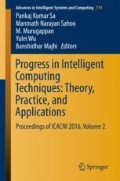Abstract
Today because of the popularity of e-commerce sites, spammers have made their target to these sites for review spam apart from other spams like email spam or web spam. These fake reviews written by fraudsters prevent customers and organizations reaching actual conclusions about the products. Hence, these must be detected and eliminated so as to prevent deceptive potential customers. In this paper, we have used semi-supervised learning technique to detect review spam. The proposed work is based on PU-learning algorithm which learns from a very few positive example and unlabeled data set. Maximum accuracy we have achieved is of 78.12% with F-score 76.67 using only 80 positive example as a training set.
References
Fette, Ian, Norman Sadeh, and Anthony Tomasic.: Learning to detect phishing emails. In: Proceedings of the 16th international conference on World Wide Web. ACM, 2007.
Li, Wenbin, Ning Zhong, and Chunnian Liu.: Combining multiple email filters based on multivariate statistical analysis. In: Foundations of Intelligent Systems. Springer Berlin Heidelberg, 2006. 729–738.
Spirin, Nikita, and Jiawei Han.: Survey on web spam detection: principles and algorithms. In: ACM SIGKDD Explorations Newsletter 13.2 (2012): 50–64.
Abernethy, Jacob, Olivier Chapelle, and Carlos Castillo.: Graph regularization methods for web spam detection. Machine Learning 81.2 (2010): 207–225.
Karami, Amir, and Lina Zhou.: Improving static SMS spam detection by using new content-based features. (2014).
Jindal, Nitin, and Bing Liu.: Opinion spam and analysis. In: Proceedings of the 2008 International Conference on Web Search and Data Mining. ACM, 2008.
Ott, Myle, et al.: Finding deceptive opinion spam by any stretch of the imagination. In: Proceedings of the 49th Annual Meeting of the Association for Computational Linguistics: Human Language Technologies-Volume 1. Association for Computational Linguistics, 2011.
Ott, Myle, Claire Cardie, and Jeffrey T. Hancock.: Negative Deceptive Opinion Spam. In: HLT-NAAC L. 2013.
Hernndez, D., et al.: Using PU-learning to detect deceptive opinion spam.: Proc. of the 4th Workshop on Computational Approaches to Subjectivity, Sentiment and Social Media Analysis., 2013.
Liu, Bing, et al.: Partially supervised classification of text documents. ICML. Vol. 2. 2002.
Author information
Authors and Affiliations
Corresponding author
Editor information
Editors and Affiliations
Rights and permissions
Copyright information
© 2018 Springer Nature Singapore Pte Ltd.
About this paper
Cite this paper
Narayan, R., Rout, J.K., Jena, S.K. (2018). Review Spam Detection Using Semi-supervised Technique. In: Sa, P., Sahoo, M., Murugappan, M., Wu, Y., Majhi, B. (eds) Progress in Intelligent Computing Techniques: Theory, Practice, and Applications. Advances in Intelligent Systems and Computing, vol 719. Springer, Singapore. https://doi.org/10.1007/978-981-10-3376-6_31
Download citation
DOI: https://doi.org/10.1007/978-981-10-3376-6_31
Published:
Publisher Name: Springer, Singapore
Print ISBN: 978-981-10-3375-9
Online ISBN: 978-981-10-3376-6
eBook Packages: EngineeringEngineering (R0)

